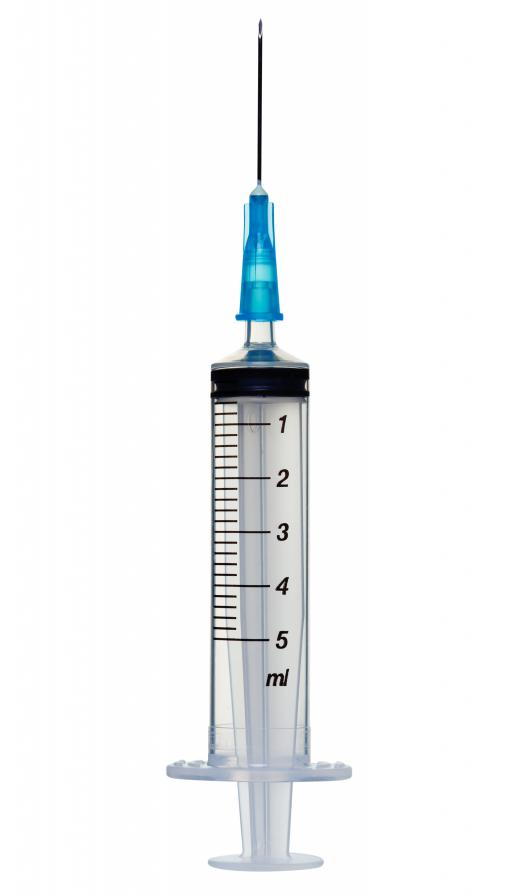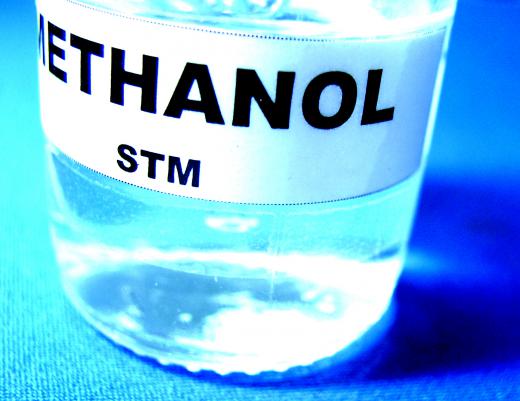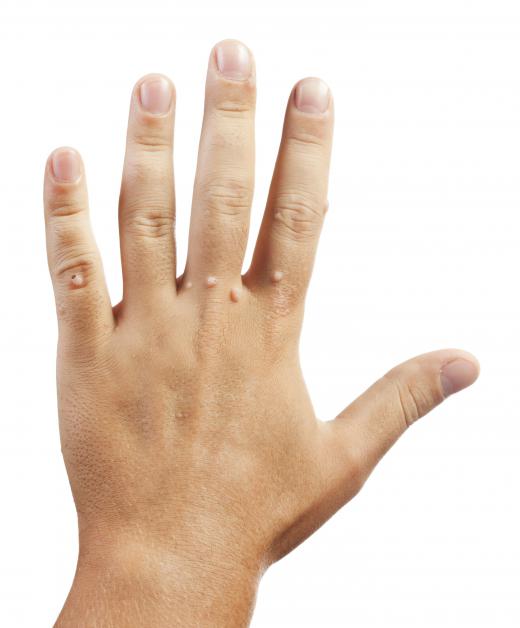What is Formalin?
 Niki Foster
Niki Foster
Formalin is a solution in water of the gas formaldehyde (CH2O). A saturated solution contains about 40% by volume — or 37% by weight — of the gas, plus a small amount of a stabilizer, usually 10-12% methanol; this prevents polymerization. The liquid is used as an embalming fluid and for the preservation of animal specimens and tissue samples. It is also used, generally in a much more dilute form, as a disinfectant, and anti-bacterial wash and in aquariums for treating parasite infections in fish. The disinfectant properties of the solution are due to the presence of formaldehyde, which also gives it a pungent, irritating smell.
Manufacture

Formaldehyde is manufactured industrially by the oxidation of methanol. Large amounts of the chemical are made this way for use in the production of plastics and resins. Formalin is produced by dissolving the gas in water until the desired concentration is reached, up to a maximum of 40%. Since water is the other product of the reaction, the process can produce formalin directly. Formaldehyde in aqueous solution is unstable and tends to polymerize, forming larger molecules that are insoluble and therefore precipitate out of the solution. For this reason, methanol, which prevents polymerization, is added to the solution.
Properties

Formalin is a colorless liquid with a strong, irritating smell, due to the off gassing of formaldehyde. It is this compound that is mainly responsible for the solution’s chemical properties. The solution is neutral in terms of acidity and alkalinity, but it can be oxidized to produce formic acid. As it can be oxidized easily, it is a reducing agent. Strong formalin solutions are flammable, burning to produce carbon dioxide and water.
Uses

Formaldehyde solutions can be used as disinfectants and germicides, as they quickly kill bacteria and other potentially harmful microorganisms. They have a dehydrating effect and also combine with proteins, inactivating them and killing cells. Because of these properties, formalin is commonly used in aquariums to kill parasites that live on fish. It is used for this purpose only in very dilute solutions to avoid harming the fish.

In histology and related disciplines, formalin is widely used for preserving tissue samples, a process known as fixing. The compound links protein molecules together, increasing the rigidity of the sample and making it easier to prepare thin slices for microscopic examination. It also prevents decay. A 10% solution is normally used; since this is prepared with standard 40% formalin, the resulting liquid contains 4% formaldehyde.

The preservative properties of this solution make it well suited to the long-term storage of animal and organ specimens, which may be held in large glass jars filled with formalin. It is also used as a preservative in vaccines. One of the best-known uses of this solution has been as an embalming agent. It is able to penetrate deep into the tissue, not only killing bacteria, but also helping the structures of the body retain their shape. Cells altered by formaldehyde also resist future attack by bacteria and other microorganisms. It is, however, no longer widely used for this purpose, because of health and safety concerns.
Another use is as a treatment for warts. It can be applied, heavily diluted, as a gel or solution. The compound seems to work by damaging the skin cells of warts and possibly killing the virus responsible. It can, however, cause an allergic reaction in some people.
Health and Safety Issues
There are a number of hazards associated with the use of formalin. It readily releases formaldehyde gas, which is both toxic and highly flammable. Accidental spillage of the solution can quickly raise the concentration of this gas to dangerous levels, posing a direct threat to health and the risk of fire or explosion.
If swallowed, the solution has a corrosive effect on the mouth, tongue and esophagus, causing pain, vomiting and bleeding. Other symptoms include kidney failure, effects on the central nervous system and coma. The lethal dose for humans may be around 1 oz (30 ml).
People are more likely to suffer ill effects through inhalation of the vapor. At low levels, it is irritating to the eyes and nose and can cause headaches. At higher levels, inhalation can lead to bronchitis and accumulation of fluid in the lungs. Contact with the skin may cause irritation or dermatitis. Eye contact with very dilute solutions causes irritation, but higher concentrations may damage the cornea and cause loss of vision.
AS FEATURED ON:
AS FEATURED ON:















Discussion Comments
How much formaldehyde do you people think there is in vaccines?
Vaccines have no more than 0.02mg of formaldehyde per shot; if you eat an organic non-GMO pear you will ingest 9.9mg of naturally occurring formaldehyde that mother nature put there - nearly 500 times as much!
The dose makes the poison.
It's also used to control some very nasty bacteria, by direct application on infected sites, that can decimate certain livestock. CL as it is called, has no cure.
This is why many people refuse to have their children immunized!
I am shocked to know that this or straight up formaldehyde is used in almost all of children's vaccinations in the U.S. That is why I was looking up info on it. The CDC lists the ingredients on it's website. You can find it by going to the cdc website. Needless to say, I don't vaccinate my children.
I am doing an assignment on histology and I have to research how formalin would appear if it is degraded. Could someone please tell me?
During metabolism, methanol converts to formaldehyde. Formaldehyde can convert to formic acid. Aspartame releases aspartic acid during metabolism, which converts to methanol.
Formalin is extremely unhealthy. It's a known carcinogen (if you don't believe me check the MSDS). We use it where I work and you have to wear a mask or use a vent hood; you do not want to breathe the stuff. And people are soaking their feet in it? What?
@anon179568: Let's put it this way: I use a formalin mix to preserve my zooplankton samples and after it is added to water in the sample and sits around for months, the only approved way to disposed of it is through the hazmat team. I think soaking your feet in formalin is a horrible, horrible idea. It is *not* safe.
so is this safe for humans or not?
I use formalin for athletes foot (recommended by a friend). I soak my feet in it for one minute, once a day for three days and it clears it for months. But after reading about its properties, i don't think I should be doing this.
@boathugger: To add to the last article, during the Civil War, a large amount of victims bled to death. Dr. Richard Burr designed the basic art of the modern embalming practice, the concept of arterial embalming. These unfortunate soldiers were the first to be chemically embalmed.
Several different chemicals were experimented with over the years, including creosote, mercury, turpentine, and even arsenic. Formaldehyde was finally introduced in 1868.
Formaldehyde was discovered by a Russian chemist by the name of Aleksandr Butlerov. Formaldehyde is highly toxic to the living but is a miracle drug for the dead.
@boathugger: Here's a little history on embalming: What could be considered the earliest form of embalming took place over 6,000 years ago when residents of South America salted dead bodies to preserve them. The ancient Egyptians advanced the art of embalming with the system known as mummification.
However, after Alexander the Great destroyed the monarchy, mummification suddenly seemed like too much trouble. Alexander was embalmed in beeswax and honey, by the way. People started just burying corpses in the ground and that was that.
Embalming came back around during the American Civil War. Officers of privilege were often shipped home for funerals and some type of embalming was regularly done for $100 a head.
I am taking a Death and Dying class in college and we have to do a report on enbalming. Does anyone have any information that I might could add to my report that I might not have?
Very informative article!
Post your comments